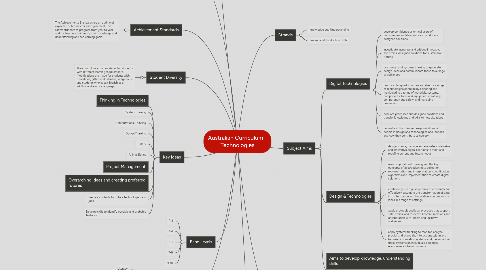
1. Band Levels
1.1. F-2
1.2. 3-4
1.3. 5-6
1.4. 7-8
1.5. 9-10
2. General Capabilities
2.1. Literacy
2.2. Numeracy
2.3. ICT
2.4. Critical and Creative Thinking
2.5. Personal and Social Capability
2.6. Ethical Understanding
2.7. Intercultural Understanding
3. Key Ideas
3.1. Thinking in Technologies
3.2. System thinking
3.3. Computational Thinking
3.4. Design Thinking
3.5. Safety
3.6. Animal Ethics
3.7. Project Management
3.8. Overarching ideas and creating preferred futures
3.9. Prepare students for future technologies and jobs.
3.10. Develop skills to identify possible and probable features.
4. Student Diversity
4.1. The curriculum accommodates for students with different learning requirements. Modifications are made for students with disabilities, gifted and talented, Indigenous and students who speak English as an additional dialect or language.
5. Cross-curriculum priorities
5.1. Asia and Australia's engagement with Asia
5.2. Sustainability
5.3. Aboriginal & Torres Strait Islander Histories & Cultures
6. Achievement Standards
6.1. The Achievements Standards are an outline of expected outcomes for each year level. This allows students to progress from year to year and for teachers to identify their knowledge and understanding and set learning goals.
7. Content Descriptors and elaborations
7.1. Content Descriptors outline on what needs to taught in each leaning area. The elaborations expand on the content descriptors further and provide ideas and demonstrate links to other learning areas and General Capabilities.
8. Links to Other Learning Areas
8.1. Health and Physical Education
8.2. English
8.3. Mathematics
8.4. The Arts
8.5. Science
8.6. Humanities & Social Science
9. Rationale
9.1. Technologies are important in developing skills for students to be prepared for current and future ideas and needs. creating innovative solutions , independently and collaboratively, developing knowledge.
10. Subject Aims
10.1. Digital Technologies
10.1.1. develop confidence as critical users of technologies and designers and producers of designed solutions
10.1.2. investigate, generate and critique innovative and ethical designed solutions for sustainable futures
10.1.3. use design and systems thinking to generate design ideas and communicate these to a range of audiences
10.1.4. produce designed solutions suitable for a range of technologies contexts by selecting and manipulating a range of materials, systems, components, tools and equipment creatively, competently and safely; and managing processes
10.1.5. evaluate processes and designed solutions and transfer knowledge and skills to new situations
10.1.6. understand the roles and responsibilities of people in design and technologies occupations and how they contribute to society.
10.2. Design & Technologies
10.2.1. design, create, manage and evaluate sustainable and innovative digital solutions to meet and redefine current and future needs
10.2.2. use computational thinking and the key concepts of abstraction; data collection, representation and interpretation; specification, algorithms and implementation to create digital solutions
10.2.3. confidently use digital systems to efficiently and effectively automate the transformation of data into information and to creatively communicate ideas in a range of settings
10.2.4. apply protocols and legal practices that support safe, ethical and respectful communications and collaboration with known and unknown audiences
10.2.5. apply systems thinking to monitor, analyse, predict and shape the interactions within and between information systems and the impact of these systems on individuals, societies, economies and environments.
